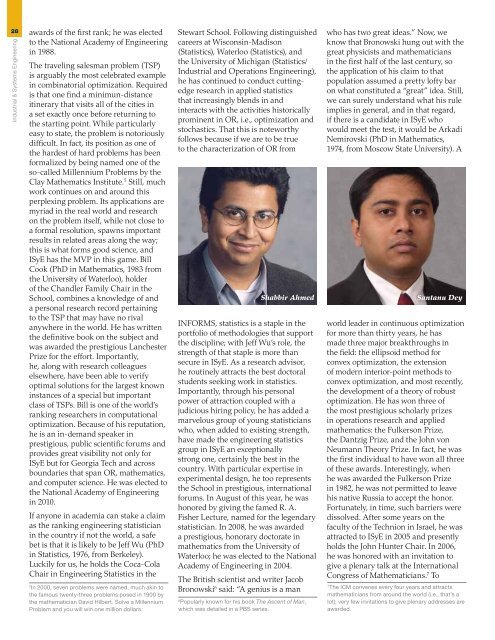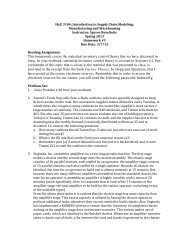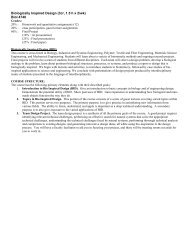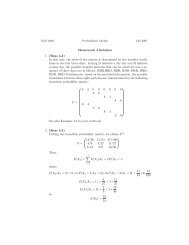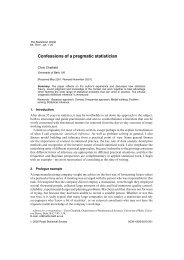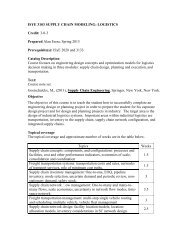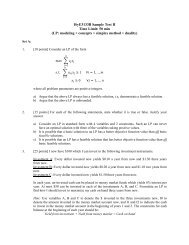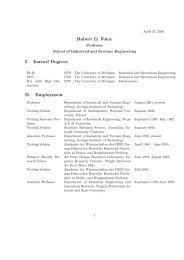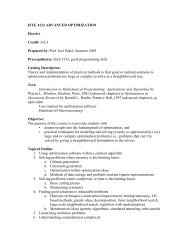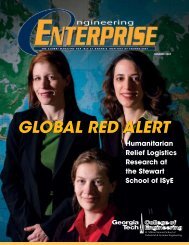Fall 2011 - H. Milton Stewart School of Industrial & Systems ...
Fall 2011 - H. Milton Stewart School of Industrial & Systems ...
Fall 2011 - H. Milton Stewart School of Industrial & Systems ...
Create successful ePaper yourself
Turn your PDF publications into a flip-book with our unique Google optimized e-Paper software.
28<br />
<strong>Industrial</strong> & <strong>Systems</strong> Engineering<br />
awards <strong>of</strong> the first rank; he was elected<br />
to the National Academy <strong>of</strong> Engineering<br />
in 1988.<br />
The traveling salesman problem (TSP)<br />
is arguably the most celebrated example<br />
in combinatorial optimization. Required<br />
is that one find a minimun-distance<br />
itinerary that visits all <strong>of</strong> the cities in<br />
a set exactly once before returning to<br />
the starting point. While particularly<br />
easy to state, the problem is notoriously<br />
difficult. In fact, its position as one <strong>of</strong><br />
the hardest <strong>of</strong> hard problems has been<br />
formalized by being named one <strong>of</strong> the<br />
so-called Millennium Problems by the<br />
Clay Mathematics Institute. 5 Still, much<br />
work continues on and around this<br />
perplexing problem. Its applications are<br />
myriad in the real world and research<br />
on the problem itself, while not close to<br />
a formal resolution, spawns important<br />
results in related areas along the way;<br />
this is what forms good science, and<br />
ISyE has the MVP in this game. Bill<br />
Cook (PhD in Mathematics, 1983 from<br />
the University <strong>of</strong> Waterloo), holder<br />
<strong>of</strong> the Chandler Family Chair in the<br />
<strong>School</strong>, combines a knowledge <strong>of</strong> and<br />
a personal research record pertaining<br />
to the TSP that may have no rival<br />
anywhere in the world. He has written<br />
the definitive book on the subject and<br />
was awarded the prestigious Lanchester<br />
Prize for the effort. Importantly,<br />
he, along with research colleagues<br />
elsewhere, have been able to verify<br />
optimal solutions for the largest known<br />
instances <strong>of</strong> a special but important<br />
class <strong>of</strong> TSPs. Bill is one <strong>of</strong> the world’s<br />
ranking researchers in computational<br />
optimization. Because <strong>of</strong> his reputation,<br />
he is an in-demand speaker in<br />
prestigious, public scientific forums and<br />
provides great visibility not only for<br />
ISyE but for Georgia Tech and across<br />
boundaries that span OR, mathematics,<br />
and computer science. He was elected to<br />
the National Academy <strong>of</strong> Engineering<br />
in 2010.<br />
If anyone in academia can stake a claim<br />
as the ranking engineering statistician<br />
in the country if not the world, a safe<br />
bet is that it is likely to be Jeff Wu (PhD<br />
in Statistics, 1976, from Berkeley).<br />
Luckily for us, he holds the Coca-Cola<br />
Chair in Engineering Statistics in the<br />
5<br />
In 2000, seven problems were named, much akin to<br />
the famous twenty-three problems posed in 1900 by<br />
the mathematician David Hilbert. Solve a Millennium<br />
Problem and you will win one million dollars.<br />
<strong>Stewart</strong> <strong>School</strong>. Following distinguished<br />
careers at Wisconsin-Madison<br />
(Statistics), Waterloo (Statistics), and<br />
the University <strong>of</strong> Michigan (Statistics/<br />
<strong>Industrial</strong> and Operations Engineering),<br />
he has continued to conduct cuttingedge<br />
research in applied statistics<br />
that increasingly blends in and<br />
interacts with the activities historically<br />
prominent in OR, i.e., optimization and<br />
stochastics. That this is noteworthy<br />
follows because if we are to be true<br />
to the characterization <strong>of</strong> OR from<br />
Shabbir Ahmed<br />
INFORMS, statistics is a staple in the<br />
portfolio <strong>of</strong> methodologies that support<br />
the discipline; with Jeff Wu’s role, the<br />
strength <strong>of</strong> that staple is more than<br />
secure in ISyE. As a research advisor,<br />
he routinely attracts the best doctoral<br />
students seeking work in statistics.<br />
Importantly, through his personal<br />
power <strong>of</strong> attraction coupled with a<br />
judicious hiring policy, he has added a<br />
marvelous group <strong>of</strong> young statisticians<br />
who, when added to existing strength,<br />
have made the engineering statistics<br />
group in ISyE an exceptionally<br />
strong one, certainly the best in the<br />
country. With particular expertise in<br />
experimental design, he too represents<br />
the <strong>School</strong> in prestigious, international<br />
forums. In August <strong>of</strong> this year, he was<br />
honored by giving the famed R. A.<br />
Fisher Lecture, named for the legendary<br />
statistician. In 2008, he was awarded<br />
a prestigious, honorary doctorate in<br />
mathematics from the University <strong>of</strong><br />
Waterloo; he was elected to the National<br />
Academy <strong>of</strong> Engineering in 2004.<br />
The British scientist and writer Jacob<br />
Bronowski 6 said: “A genius is a man<br />
6<br />
Popularly known for his book The Ascent <strong>of</strong> Man,<br />
which was detailed in a PBS series.<br />
who has two great ideas.” Now, we<br />
know that Bronowski hung out with the<br />
great physicists and mathematicians<br />
in the first half <strong>of</strong> the last century, so<br />
the application <strong>of</strong> his claim to that<br />
population assumed a pretty l<strong>of</strong>ty bar<br />
on what constituted a “great” idea. Still,<br />
we can surely understand what his rule<br />
implies in general, and in that regard,<br />
if there is a candidate in ISyE who<br />
would meet the test, it would be Arkadi<br />
Nemirovski (PhD in Mathematics,<br />
1974, from Moscow State University). A<br />
Santanu Dey<br />
world leader in continuous optimization<br />
for more than thirty years, he has<br />
made three major breakthroughs in<br />
the field: the ellipsoid method for<br />
convex optimization, the extension<br />
<strong>of</strong> modern interior-point methods to<br />
convex optimization, and most recently,<br />
the development <strong>of</strong> a theory <strong>of</strong> robust<br />
optimization. He has won three <strong>of</strong><br />
the most prestigious scholarly prizes<br />
in operations research and applied<br />
mathematics: the Fulkerson Prize,<br />
the Dantzig Prize, and the John von<br />
Neumann Theory Prize. In fact, he was<br />
the first individual to have won all three<br />
<strong>of</strong> these awards. Interestingly, when<br />
he was awarded the Fulkerson Prize<br />
in 1982, he was not permitted to leave<br />
his native Russia to accept the honor.<br />
Fortunately, in time, such barriers were<br />
dissolved. After some years on the<br />
faculty <strong>of</strong> the Technion in Israel, he was<br />
attracted to ISyE in 2005 and presently<br />
holds the John Hunter Chair. In 2006,<br />
he was honored with an invitation to<br />
give a plenary talk at the International<br />
Congress <strong>of</strong> Mathematicians. 7 To<br />
7<br />
The ICM convenes every four years and attracts<br />
mathematicians from around the world (i.e., that’s a<br />
lot); very few invitations to give plenary addresses are<br />
awarded.


